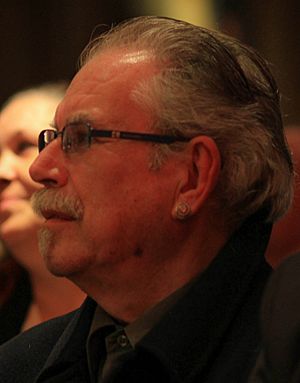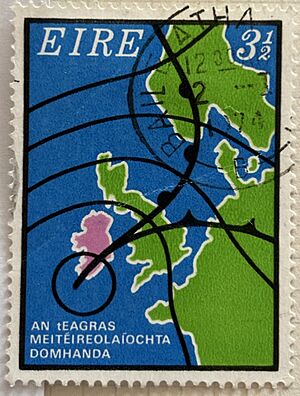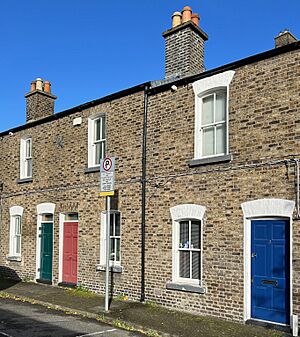Robert Ballagh facts for kids
Robert Ballagh (born 22 September 1943) is a famous Irish artist. He is a painter and designer from Dublin. Robert Ballagh's early paintings were influenced by pop art. This style uses images from popular culture, like advertisements.
He is also known for his very realistic paintings of Irish writers and important people. He designed over 70 Irish postage stamps and a series of banknotes. Ballagh also created amazing sets for plays, including for Riverdance. His art has been shown in many places around the world since 1967. You can find his work in many museums and galleries. He was chosen to represent Ireland at a big art show in Paris in 1969.
Robert Ballagh has always lived in Dublin. He became a member of Aosdána, which is Ireland's group for artists. He also helped start the Irish Visual Artists Rights Organisation. He has received many awards, including an honorary degree from UCD. He has published a book of photos of Dublin and a book about his life.
Contents
Early Life and Education
Robert Ballagh was born on 22 September 1943. He grew up in Ballsbridge, Dublin. He was the only child of Nancy and Bobbie Ballagh. His parents were both good at sports and played for Ireland.
His father managed a shirt department in a shop. His mother stopped working after she got married. Robert went to private schools, including St Michael's College. During his teenage years, he decided he did not believe in God.
His parents were part of the Royal Dublin Society. Robert spent time in its library looking at art books. He also collected American comics and loved watching sign painters work. He started taking art seriously in 1959. Some of his early works were later shown in an exhibition.
After finishing school, Ballagh studied architecture for three years. He went to Bolton Street College of Technology. But he soon realized that architecture was not for him. He wanted to focus on art and music instead.
Artistic Career
Before becoming a full-time artist, Robert Ballagh was a professional musician. For about three years, he played bass guitar in bands like The Chessmen. He toured Ireland and England with them. Even though he earned good money, he decided music wasn't his path. He sold his guitar and stopped playing music.
Ballagh then worked as a draughtsman, postman, and designer. He decided to become a dedicated artist after meeting a friend, Micheal Farrell. Farrell asked him to help with a large painting for a bank. This huge painting was made at Ardmore Studios.
Painting and Sculpture
In 1967, two of Ballagh's early sculptures were shown at the Irish Exhibition of Living Art. Since then, his work has been in many group exhibitions. The Arts Council of Ireland also bought one of his early paintings.
Ballagh mostly taught himself art. His early work was inspired by pop art. He created series of paintings like the Package series and Map series. He then started painting about political topics. These included issues in Northern Ireland and the Civil Rights movement in the US. He also painted three important works inspired by famous historical paintings.
In 1972, he created an art piece to remember the victims of Bloody Sunday in Derry. It showed thirteen figures made of sand on the floor, with animal blood sprinkled on them.
Ballagh began painting portraits in 1971. He painted many famous people, including writers like James Joyce and Oscar Wilde. He also painted scientists like James D Watson. One of his portraits of Watson hangs in Trinity College Dublin. By 2010, he had painted 91 portraits of people outside his family.
He also created self-portraits and paintings of his family. These works often showed his family in their home. He even used his daughter as a model for paintings inspired by Marilyn Monroe.
After many years, Ballagh started painting landscapes in the late 1990s. His 2002 exhibition, Tir is Teanga (meaning Land and Language), showed 10 landscapes. These were not of specific places but showed typical Irish scenes. He also painted the Fastnet Lighthouse for the Irish lighthouse authority.
Ballagh has also been a judge for art competitions. He has led community art projects in Dublin and Belfast. He even taught art in prisons. One of his community art projects in Dublin, a huge mural, was featured in a TV show.
Artist's Studio
For many years, Ballagh had a studio on Parliament Street in Dublin. It overlooked City Hall. In the 1990s, he bought a new building on Arbour Hill. He turned it into his studio and a small apartment. Ballagh sometimes works very slowly and with great detail. For example, in 1982, he only finished two paintings. His art has sold very well at auctions. One painting, My Studio 1969, sold for 96,000 euro in 2004.
Postage Stamp and Banknote Design
Robert Ballagh has designed over 70 Irish postage stamps. He also designed a series of Irish banknotes, called "Series C". These were the last Irish banknotes before the euro was introduced.
His first stamp design came out on 4 September 1973. It celebrated 100 years of the World Meteorological Organization. The stamp showed a weather map of northwestern Europe. Ballagh's map of Ireland did not show the border with Northern Ireland. This caused some discussion at the time.
He designed stamps for many other events. These included 100 years of the Universal Postal Union and the first telephone call. He also designed stamps for the birthdays of important Irish figures. Some of his stamp designs were about Scouting and Irish festivals. One stamp design was even rejected by the government after it was printed. It was later released more than 15 years later.
Theatre Set and Other Design Work
Ballagh has designed sets for plays and shows both in Ireland and internationally. He was asked to try this type of work by Michael Colgan, a theatre director.
He designed sets for Riverdance on its international tour. He also designed sets for plays by famous writers like Samuel Beckett and Oscar Wilde. Other plays he worked on include Hamlet and Three Sisters.
For Riverdance, he created about 50 small images. These images were then projected to create the backdrops for the show. He had to change his designs to fit different theatres around the world.
Ballagh also designed the opening ceremonies for two big sports events in Ireland. These were the 2003 Special Olympics World Summer Games and the 2006 Ryder Cup. He also created a "living artwork" for an event. This was inspired by the famous painting The Girl with a Pearl Earring.
In other design work, he created a masthead for the Irish Examiner newspaper. He also designed a cover for a music single.
Exhibitions
Solo Exhibitions
Robert Ballagh has had many solo art shows. These have been in Dublin, Brussels, Paris, Lund (Sweden), Warsaw, Moscow, and Sofia. His first exhibition was in 1969 in Dublin.
Later shows in Ireland included ones in Cork and Dublin. After his main art dealer passed away, Ballagh decided to work without a Dublin dealer. His next big show of new work in Dublin was in 2009. This show, "Tir is Teanga," featured paintings with natural materials like stones and sand.
In 1989, he was invited to have a major exhibition in Moscow. He was only the second Irish person to be invited to such a show there.
Ballagh had his first big exhibition looking back at his whole career in 1992. It was held at the Arnotts department store in Dublin. This show included 100 examples of his work. It featured paintings, portraits, stamp designs, and theatre sets.
More exhibitions followed, including a very important one at the Royal Hibernian Academy. There was also a show at the Gorry Gallery called Works from the Studio, 1959-2006. In 2013, an exhibition called Seven showed seven portraits of important people and seven self-portraits.
Major Group Exhibitions
Ballagh's art was shown at the Irish Exhibition of Living Art (IELA) in 1967 and 1968. In 1969, he and other artists refused to send their work to Belfast due to violence. Instead, their art was shown in an exhibition called Art and Conscience.
He was also invited to show his work at Rosc in 1980. In 1987, he took part in a peace forum and art exhibition in the Soviet Union. This was a rare invitation for an Irish artist. At this event, he met famous people like Gregory Peck and Yoko Ono.
Ballagh's work has been shown in exhibitions in Florence and Tokyo. His art also toured the US from 1985 to 1987.
Awards and Leadership Roles
Ballagh won the Carroll Prize at IELA in 1969. He also received the Alice Berger Hammerschlag Award in 1971.
He was a founding member of Aosdána, Ireland's national academy for artists, in 1981. He was also its first chairperson. He later stepped back from this role. He was also made a fellow of the World Academy of Art and Science. In 2013, he received an honorary doctorate from University College Dublin. In 2016, he received a Lord Mayor's Award in Dublin.
Two of his artworks won the Douglas Hyde Gold Medal at the Oireachtas Exhibition. One of his pieces, Northern Ireland, The 1,500th Victim (1976), was chosen as one of the "Modern Ireland in 100 Artworks" by the Royal Irish Academy.
Ballagh was the first chairperson of the Artists Association of Ireland. He also helped start the Irish Visual Artists Rights Organisation.
Art Collections
Robert Ballagh's paintings are held in many public art collections. These include the National Gallery of Ireland and the Hugh Lane Gallery in Dublin. His work is also in the Ulster Museum, the Irish Museum of Modern Art, and the Crawford Art Gallery in Cork. Other places holding his art include Trinity College Dublin and museums in Switzerland and Germany.
Artistic Style
Ballagh has said that he hopes his paintings will last beyond their time, but also reflect their time. He admires Picasso for having many different styles and approaches.
Some art experts have commented on Ballagh's work. Declan Kiberd said that Ballagh is a major example of an Irish artist who is also an activist. Brian O'Doherty noted that his art is made by a very political person, even if it's not always "political art." Roderic Knowles pointed out his move from abstract art to realistic figures. He also mentioned Ballagh's humor and social comments in his work.
Interests and Activism
Artists' Rights
Robert Ballagh has long fought for artists' rights. He believes artists should get fair payment when their work is resold. He also campaigns for more funding for the arts. He worked with the International Association of Art, an organization for artists worldwide. He served as treasurer for three years. Ballagh believes Ireland's funding for the arts is not as good as other countries.
Politics and Irish History
Ballagh says his interest in politics began in 1968. This was when he heard about civil rights protestors being attacked in Derry, Northern Ireland. In 1988, he helped with the West Belfast Féile an Phobail arts festival.
In 1989, he helped start the Irish National Congress. He led it for 10 years. In 1991, he helped organize the 75th anniversary of the 1916 Easter Rising. He said that the Easter Rising was led by "poets, actors, writers, musicians, social reformers."
He is the president of the Ireland Institute for Historical and Cultural Studies. This group promotes studies of Irish history.
Palestine
In 2011, Ballagh disagreed with the Riverdance show performing in Israel. He is an active member of the Ireland Palestine Solidarity Campaign. This group asks artists to support boycotts of Israeli businesses and cultural places.
Closure of Irish Galleries
In 2012, Ballagh expressed sadness about Irish galleries and museums closing. He said he was "ashamed and profoundly depressed." He gave an example of tourists who found many parts of the National Gallery closed. He also mentioned that the Museum of Modern Art was closed. Ballagh said that while arts funding might not seem important to everyone, it is "about the soul of the nation."
Publications and Appearances
In the 1980s, Ballagh published a book of photos of Dublin. The book showed less-known parts of the city. It included quotes from James Joyce. A book about Robert Ballagh's art was published in 2010.
He also published a paper called "Who fears to speak of the Republic?" in a journal. In 2018, he released a book about his life called A Reluctant Memoir. This book shares short stories about important events in his life.
Documentaries have been made about Robert Ballagh by the BBC and Igloo Films. In 2019, he appeared on RTÉ's Celebrity Home of the Year TV show. His house came in second place.
Personal Life
Robert Ballagh met his wife, Betty (Elizabeth Carabini), in 1965. She was 16 and he was playing a music gig. They had two children, Rachel (born 1968) and Robert Bruce (born 1974 or 1975). Rachel also became an artist.
When he was a young artist, Ballagh sometimes had to sign up for unemployment benefits. This was when he was looking for paid work. He has noted that income for artists can be uncertain.
The couple bought and combined several small houses into one large home. This building, called Ballagh House, was featured in an architecture magazine and on TV.
Betty Ballagh had a serious brain injury in 1986. It took her years to fully recover. Robert's parents passed away in 1990. Betty died in 2011.
By the mid-2000s, he had two grandchildren. He had treatment for a type of blood cancer and recovered. He later received a diagnosis of type II diabetes. As of 2021, Ballagh still lives in Broadstone and works in his studio in Arbour Hill.




